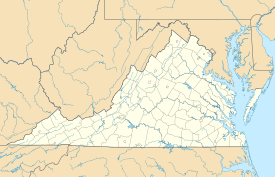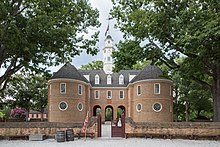Virginia State Capitol
| Virginia State Capitol | ||
|---|---|---|
| National Register of Historic Places | ||
| National Historic Landmark | ||
|
|
||
| location | Richmond , Virginia | |
| Coordinates | 37 ° 32 '19.5 " N , 77 ° 26' 0.9" W | |
| Built | 1785-1792 | |
| architect | Thomas Jefferson , Charles-Louis Clérisseau | |
| Architectural style | Federal Style , Palladianism | |
| NRHP number | 66000911 | |
| Data | ||
| The NRHP added | October 15, 1966 | |
| Declared as an NHL | December 19, 1960 | |
The Virginia State Capitol is the seat of government of the state of Virginia and houses the Virginia General Assembly, the oldest legislative body in the western hemisphere. It is located in Virginia's capital, Richmond . At over 220 years old, the Virginia State Capitol is the third oldest state capitol in use. Nevertheless, it is already the eighth parliament building in the state.
Previous buildings
In 1619, during the colony of Virginia, the first elected General Assembly ( House of Burgesses ) was called in Jamestown . The Virginia Company created this to encourage immigration to the colony. They gathered in Jamestown Church.
After the government building in Jamestown burned down again in 1698, the government moved to Williamsburg in 1690 , further inland and away from the swampy, mosquito-infested area around Jamestown.
From 1705 the general assembly met in a newly constructed two-story building, which actually consisted of two buildings connected by an arcade and housed several institutions. It also burned down in 1747 and was replaced by a new building by 1753. Here on May 15, 1776, Virginia declared its independence from Great Britain.
During the American War of Independence , at the urging of the Governor of Virginia and later President Thomas Jefferson, the capital was moved further inland, to Richmond, in order to forestall a siege by the approaching British troops. The last session in the Williamsburg Parliament House was on December 24, 1779.
Over time it fell into disrepair and was eventually demolished for the extraction of building materials. The first Williamsburg Capitol was reconstructed in 1934 as part of the Colonial Williamsburg Open Air Museum .
The current building
In Richmond they first met in a makeshift building. Shockoe Hill, a centrally located elevation with a view over the James River , was chosen as the location for the new parliament building of the young state .
The design comes from Jefferson and the French architect Charles-Louis Clérisseau . It was based on one of the best-preserved Roman temples in Europe, the Maison Carrée in the southern French city of Nîmes . Instead of the Corinthian columns , however, Ionic ones were chosen. The foundation stone was laid on August 18, 1785.
For much of the civil war , the building served as the Confederation's seat of government . Richmond was the most important metropolis in the southern states at the time. After Virginia joined the Confederation, Montgomery (Alabama) was replaced by Richmond as the capital in May 1861. Shortly before the end of the war, the government moved again to Lynchburg , where the Army of Northern Virginia surrender declaration was finally signed on April 9 in the Appomattox Court House , which marked the beginning of the end of the war.
On April 27, 1870, a major incident occurred: during a hearing by the court of appeal in the large courtroom on the second floor of the building, which was attended by several hundred people, the overcrowded spectator gallery collapsed and fell on the people in the hall. Due to the additional weight, the floor of the hall broke through and the negotiators fell 12 m below the ground. 62 people were killed and 251 were injured, some seriously.
Thereupon the call for the demolition of the building became loud. Instead, it was repaired and two symmetrical wings were added in 1904 . With the Ionic columns and the triangular gables resting on them, they adapt to the original building.
The surrounding green area ( Capitol Hill ) is the location of several memorials for people and events that affect the state of Virginia. The most striking is probably the nearly 6.5 m high Virginia Washington Monument , an equestrian statue of George Washington, probably Virginia's most important son. At the foot of this monument, Jefferson Davis was sworn in as the first and only President of the Confederate States.
Web links
Individual evidence
- ↑ Listing of National Historic Landmarks by State: Virginia. National Park Service , accessed March 9, 2020.
- ↑ Virginia State Capitol on the National Register of Historic Places , accessed March 9, 2020.
- ↑ Jamestown Churches . National Park Service. Retrieved February 2, 2014.
- ^ Anderson Greenspan: Creating Colonial Williamsburg: The Restoration of Virginia's Eighteenth-Century Capital , 2nd. Edition, The University of North Carolina Press, Chapel Hill 2009, ISBN 978-0-8078-3343-8 , pp. 38-39.
- ^ Leland M. Roth: Understanding Architecture: Its Elements, History and Meaning , First. Edition, Westview Press, Boulder, CO 1993, ISBN 0-06-430158-3 , p. 414.
- ^ Charles E. Brownell, et al .: The Making of Virginia Architecture . Virginia Museum of Fine Arts, 1992, pp. 46-53, 214-217.
- ↑ George L. Christian: The Capitol disaster. A chapter of reconstruction in Virginia . Richmond Press, Inc., Richmond, Virginia 1915.
- ^ National Register of Historic Places nomination . Virginia Department of Historic Resources. Archived from the original on September 27, 2012. Info: The archive link was automatically inserted and has not yet been checked. Please check the original and archive link according to the instructions and then remove this notice. Retrieved June 5, 2012.




